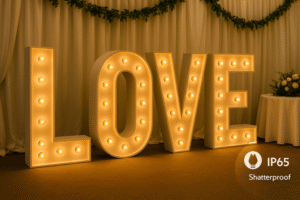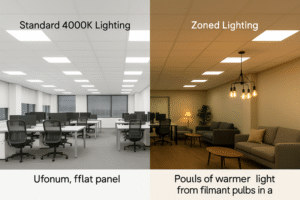You're searching for elegant candelabra bulbs, but you're stuck with generic options that lack quality. You're worried about poor performance, inconsistent supply, and prices that don't match the value you receive.
To buy quality LED candelabra bulbs, your best option is to source them directly from a specialized manufacturer. This approach ensures you get reliable performance, factory-direct pricing, and a wide selection of styles.

I've spoken with many buyers, like Jacky from America, who are tired of the same problem: finding a reliable supplier. They spend hours searching online or at trade fairs, only to find resellers who can't guarantee quality or consistent supply. As the marketing manager at Omita Lighting, a direct manufacturer, I see the other side. We control the entire process, from blowing the glass to the final assembly. This allows us to offer not just a product, but a promise of quality, reliability, and fair pricing directly from the source. It cuts out the confusion and helps businesses get exactly what they need without the hassle.
Why Should You Buy Directly from a Manufacturer?
You're dealing with middlemen who add markups and can't answer your technical questions. This process is inefficient, expensive, and you never really know the origin or true quality of the product you're buying.
Buying directly from a manufacturer like Omita Lighting provides you with guaranteed quality, reasonable factory-direct pricing, and dependable support. It eliminates unnecessary costs and communication gaps, creating a more reliable supply chain.

Going straight to the source is the most effective strategy for securing high-quality LED lighting. The traditional supply chain, with its layers of distributors and wholesalers, often creates more problems than it solves for professional buyers. Each middleman adds their own markup, inflating the final price without adding any real value to the product itself. More importantly, they create a communication barrier between you and the people who actually designed and built the bulb. As a manufacturer with 30 years of experience, we eliminate these issues by working directly with our clients. This direct partnership model provides unfiltered access to expertise, ensures product consistency from batch to batch, and creates a streamlined, efficient purchasing process. It's a fundamentally better way to do business.
Eliminating Supply Chain Inefficiencies
Working with a reseller or distributor means you are paying for their warehouse, their sales team, and their profit margin. These added costs can significantly increase the price of the final product. Direct sourcing1 cuts out these layers, allowing you to get a premium product at a more reasonable, factory-direct price. This also speeds up the entire process, from getting a quote to receiving your final shipment, because there are fewer logistical hurdles and communication points to navigate.
Gaining Unfiltered Access to Expertise
When you have a technical question or a request for a custom product, you need to speak with an expert. If you buy through a reseller, your queries have to pass through multiple people, often losing important details along the way. By communicating directly with us, the manufacturer, you get immediate answers from the engineers and product specialists who know the bulbs inside and out. This is invaluable for projects that require specific performance characteristics or unique aesthetic touches.
Ensuring Product Consistency2
A major pain point for businesses is product inconsistency. You might order a batch of bulbs that look perfect, but the next order has a slightly different color temperature or fails to dim properly. This happens when resellers source from multiple factories. A direct manufacturer, on the other hand, controls the entire production line. This guarantees that every single bulb, from the first sample to the ten-thousandth unit, meets the exact same quality and performance standards.
| Feature Comparison | Direct from Manufacturer | Through a Reseller |
|---|---|---|
| Pricing | Factory-direct, more competitive | Inflated with multiple markups |
| Quality Control | Consistent and directly managed | Variable, sourced from many factories |
| Technical Support3 | Direct access to product experts | Limited, general knowledge |
| Customization4 | Possible for specific orders | Usually not an option |
What Should You Look for in a Supplier's Product Range?
Your current supplier offers only basic, clear candelabra bulbs. This lack of variety limits your design options and prevents you from creating a unique atmosphere for your customers or in your home.
A quality supplier will offer a diverse range of candelabra bulbs, including different glass finishes like amber or smoke, various shapes, and essential features like dimmability to match any design aesthetic.
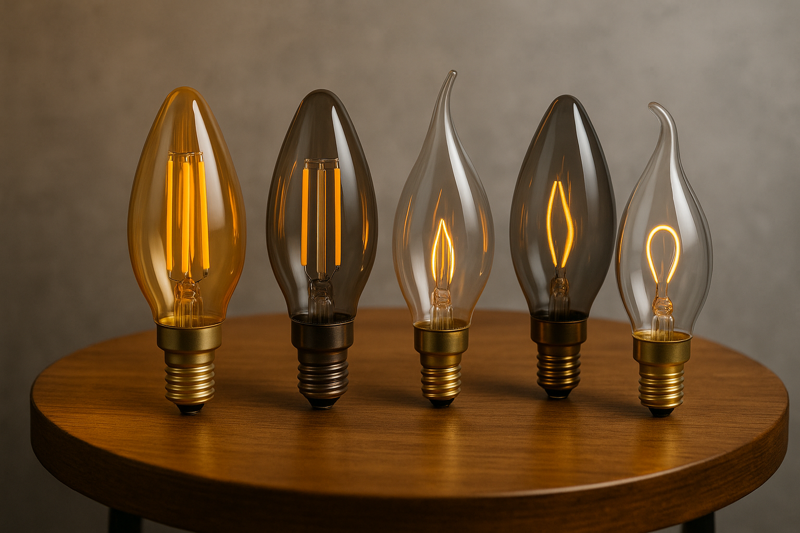
A great candelabra bulb does more than just produce light; it helps tell a story. This is why a manufacturer's product range is a clear indicator of their expertise and commitment to the industry. A supplier offering only one or two basic options is simply selling a commodity. A true lighting partner, however, understands that different environments require different lighting solutions. They invest in the tooling and craftsmanship needed to produce a wide variety of shapes, sizes, and finishes. This includes not just aesthetic options but also technical ones, such as different base types (E12 for the US, E14 for Europe) and voltage ratings to serve an international clientele. A deep and varied catalog shows that the manufacturer is in tune with the needs of designers, architects, and discerning business owners who see lighting as a critical component of their vision.
Matching Aesthetics to Atmosphere
The visual appearance of the bulb is your first tool for creating a mood. An amber-tinted glass bulb, for example, is perfect for creating a warm, vintage ambiance in a restaurant or a speakeasy-style bar. A bulb with a modern smoke finish, on the other hand, can add a touch of sophisticated drama to a contemporary home or a boutique hotel lobby. The filament style also contributes, from classic vertical lines to intricate spiral designs. A good supplier should provide a palette of these options to function as your design toolkit.
The Critical Role of Dimmability
In any versatile space, lighting cannot be static. Dimmability is a non-negotiable feature for creating atmosphere. A restaurant, for instance, needs bright, clean light during prep hours but a soft, intimate glow during dinner service. High-quality LED candelabra bulbs should offer smooth, flicker-free dimming across a wide range. A manufacturer who prioritizes this feature demonstrates an understanding of how lighting is actually used in the real world, not just how it performs in a lab.
Technical Variety for Global Needs
A reliable global supplier must cater to different international standards. The most common candelabra base in the United States is the E12, while Europe primarily uses the E14 base. An experienced manufacturer will offer products in both configurations. They should also provide bulbs that are compatible with different voltage systems (e.g., 120V and 220-240V). This technical flexibility is a key sign of a supplier who is serious about serving a global market and has the experience to do so reliably.
| Design Goal | Recommended Glass Finish | Common Shapes |
|---|---|---|
| Warm & Vintage | Amber or Gold-Tinted | Flame Tip, Classic Torpedo |
| Modern & Dramatic | Smoke or Mirrored | Globe (G45), Tubular (T25) |
| Classic & Bright | Clear Glass | Flame Tip, Bent Tip |
| Soft & Diffused | Frosted or Milky | Classic Torpedo, Globe (G45) |
How Can You Verify a Manufacturer's Quality and Reliability?
You see claims of "high quality" everywhere, but you've been burned by bulbs that flicker, fail prematurely, or have inconsistent color. You need to know how to identify a genuinely reliable manufacturer.
Verify quality by looking for specific performance metrics like a long lifespan. Choose a manufacturer that controls its production process, from raw materials to final assembly, as this demonstrates a true commitment to reliability.
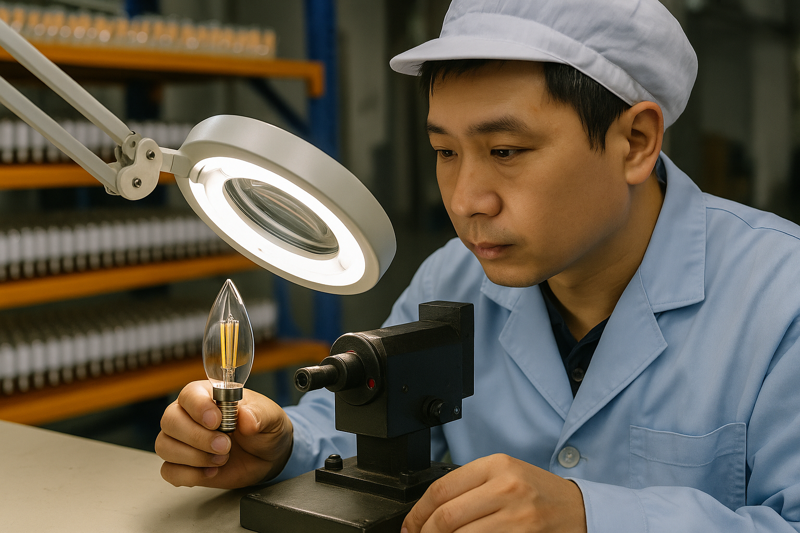
Vetting a potential manufacturing partner is one of the most critical steps for any buyer. Anyone can create a website and claim to offer "high-quality" products. A truly reliable manufacturer, however, will have tangible proof to back up their claims. This goes far beyond the basic specifications listed on a product sheet. You should look for evidence of a deep-rooted commitment to quality, which is often reflected in their years of experience, their willingness to provide samples, and their possession of internationally recognized certifications. A company like Omita, with 30 years in the industry, has a long track record of navigating complex global supply chains and maintaining high standards. We welcome a thorough vetting process because we are confident in our production capabilities and the products we ship to over 85 countries.
Look Beyond the Spec Sheet for Certifications
Product specifications are a starting point, but third-party certifications5 are proof. Look for marks like UL (for the US and Canada) or CE (for Europe), which indicate that the product has been tested by an independent body and meets strict safety and performance standards. A manufacturer who invests in these certifications is demonstrating a serious commitment to quality and market compliance. Ask potential suppliers for copies of their certification documents to verify their authenticity.
Always Request Samples for Real-World Testing
You should never place a large order without first testing a sample in your own environment. A spec sheet cannot tell you how a bulb will actually look in your chandelier or how smoothly it will dim with your specific dimmer switch. When you receive samples, check for several key things: Does the color temperature look consistent between bulbs? Is there any noticeable flicker, especially at low dimming levels? Does the build quality feel solid? This hands-on testing is the single best way to avoid disappointment and ensure the product meets your expectations.
Assess the Manufacturer's Experience and Reputation
In manufacturing, there is no substitute for experience. A company that has been in the business for decades, as we have, has weathered market changes, refined its production processes, and built a stable supply chain for raw materials. Look for case studies, client testimonials, and a professional online presence. An established manufacturer will have a history of successful partnerships and will be able to provide references upon request. This long-term stability is a strong indicator of reliability and a commitment to customer satisfaction.
| Verification Step | Why It's Important | What to Ask For |
|---|---|---|
| Check Certifications | Ensures safety and performance standards are met. | "Can you provide your UL or CE certification6 documents?" |
| Request Samples | Allows for real-world testing7 of aesthetics and function. | "Please send samples of model X for dimming and color evaluation." |
| Verify Experience | Indicates stability, expertise, and a reliable process. | "Can you share details about your company history and key markets?" |
| Ask About Warranty | Shows the company stands behind its product quality. | "What is your warranty policy for product defects?" |
Is a Lower Price Always a Better Deal for Your Business?
You're tempted by a very low price from a new supplier, but you're worried about the hidden costs. You fear that cheap bulbs will lead to unhappy customers, frequent replacements, and damage to your reputation.
No, a lower initial price is often not a better deal. It can mean inferior components, a shorter lifespan, and poor performance, leading to higher long-term costs from frequent maintenance and replacements.
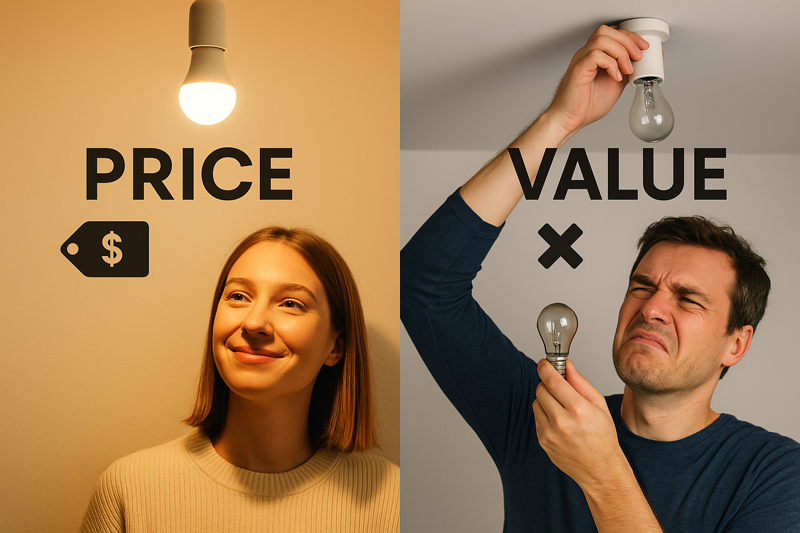
The appeal of a low price is powerful, but experienced buyers know that the purchase price is only one part of the equation. The true cost of a product is its Total Cost of Ownership (TCO), which includes not only the initial purchase but also the costs of maintenance, replacement, and even the potential impact on your brand's reputation. A cheap candelabra bulb that fails after only a few months will cost you more in labor and replacement parts than a slightly more expensive, high-quality bulb that lasts for years. At Omita, our mission is to produce high-quality and low-cost products, but we define "low-cost" in terms of long-term value, not just the upfront price tag. We use superior components and rigorous quality control to ensure our bulbs deliver lasting performance, providing our partners with a better return on their investment.
Calculating the Total Cost of Ownership
Imagine you have a chandelier with 20 bulbs. A cheap bulb might cost $2, while a quality one costs $4. The initial investment is $40 vs. $80. However, the cheap bulb fails in one year, while the quality bulb lasts for five years. Over five years, you will buy the cheap bulbs five times, costing $200. You will also pay for the labor to replace all 20 bulbs four extra times. The quality bulbs, costing only $80, require no additional labor or replacement costs during that period. The "cheaper" option ends up being significantly more expensive.
The Hidden Cost of Inconsistent Performance8
For a business, poor lighting can directly impact the customer experience. In a restaurant, flickering lights or a harsh, unflattering color rendering can make the food and the patrons look unappealing, potentially driving customers away. In a retail store, inaccurate colors can misrepresent products, leading to more returns. The money saved on cheap bulbs is quickly lost if the quality of the light negatively affects your business operations and reputation. This intangible cost is one of the most significant risks of choosing a low-price supplier.
The Value of a Long-Term Partnership9
When you invest in a quality product from a reliable manufacturer, you are also investing in a partnership. A trustworthy supplier provides more than just a box of bulbs; they offer reliable lead times, responsive customer service, and the assurance of a stable supply chain. This saves you the time and stress of constantly searching for new suppliers and dealing with inventory issues. This stability and peace of mind are invaluable assets for any business, representing a form of value that goes far beyond the per-unit price of a bulb.
| Cost Factor | Low-Price Bulb | Quality Bulb10 |
|---|---|---|
| Initial Purchase Price | Low | Moderate |
| Lifespan | Short (e.g., 1 Year) | Long (e.g., 5+ Years) |
| Replacement Cost (5 Yrs) | High | None |
| Labor Cost (5 Yrs) | High (multiple replacements) | None |
| Impact on Business | Negative (poor light quality) | Positive (great ambiance) |
| Total Cost of Ownership11 | High | Low |
Conclusion
To buy quality LED candelabra bulbs, partner directly with a trusted manufacturer who offers a diverse product range, proven reliability, and a fair balance between price and long-term value.
Explore how direct sourcing can streamline your supply chain and reduce costs effectively. ↩
Understand the significance of product consistency and how it impacts customer satisfaction and brand loyalty. ↩
Learn how direct access to technical support can enhance your product's performance and reliability. ↩
Discover the benefits of customization and how it can meet specific customer needs and enhance product appeal. ↩
Understanding third-party certifications can help you ensure product quality and safety, making informed purchasing decisions. ↩
Discovering the significance of UL and CE certifications can enhance your understanding of product safety and compliance. ↩
Learning about real-world testing can help you avoid costly mistakes and ensure product satisfaction. ↩
Explore how poor lighting can affect customer experience and business reputation. ↩
Discover how reliable suppliers can enhance your business operations and reduce stress. ↩
Learn how quality bulbs can save money in the long run and improve ambiance. ↩
Understanding TCO helps businesses make informed decisions about lighting investments. ↩






